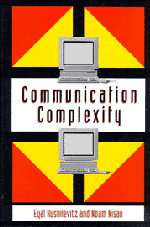Book contents
- Frontmatter
- Contents
- Preface
- I Two-Party Communication Complexity
- II Other Models of Communication
- III Applications
- 8 Networks, Communication, and VLSI
- 9 Decision Trees and Data Structures
- 10 Boolean Circuit Depth
- 11 More Boolean Circuit Lower Bounds
- 12 Time and Space
- 13 Randomness
- 14 Further Topics
- Index of Notation
- A Mathematical Background
- Answers to Selected Problems
- Bibliography
- Index
11 - More Boolean Circuit Lower Bounds
Published online by Cambridge University Press: 05 November 2009
- Frontmatter
- Contents
- Preface
- I Two-Party Communication Complexity
- II Other Models of Communication
- III Applications
- 8 Networks, Communication, and VLSI
- 9 Decision Trees and Data Structures
- 10 Boolean Circuit Depth
- 11 More Boolean Circuit Lower Bounds
- 12 Time and Space
- 13 Randomness
- 14 Further Topics
- Index of Notation
- A Mathematical Background
- Answers to Selected Problems
- Bibliography
- Index
Summary
In this chapter we describe several other ways to use communication complexity for proving various results on Boolean circuits. These results differ from those in Chapter 10 in that they do not use the connection between the circuit complexity of f and the communication complexity ofthe corresponding relation Rf and in that the circuits considered here are not restricted to use only ∨ and ∧ gates but instead use richer families of gates.
Small Circuits
A Q-circuit is a directed acyclic graph whose gates are taken from a fixed family of gates Q. Each of the gates in the family takes as an input a sequence of bits that are either inputs of the circuit or outputs of previously computed gates and its output is also a bit. The circuit defines a function over {0, 1}m in the natural way. The cost of a circuit here is its size (the number of gates). The results proved in this section can be thought of as an extension of the results proven in Section 9.1 for decision trees (Q-circuits are different than decision trees over Q in that decision trees only apply functions from Q on the input variables). In particular, we get lower bounds for the size of threshold circuits.
Definition 11.1:The Q-circuits complexity of a function f, denoted SQ(f), is the minimum cost of a Q-circuit computing f.
Recall the definition of the measure Dworst (Definition 7.1).
Lemma 11.2: Denote cQ = maxq∈QDworst(q). Then, for all f, SQ(f) ≥ Dworst(f)/cQ.
- Type
- Chapter
- Information
- Communication Complexity , pp. 131 - 138Publisher: Cambridge University PressPrint publication year: 1996



